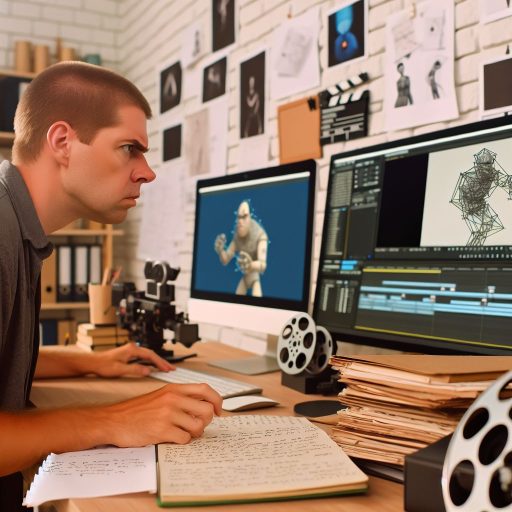Introduction
In today’s fast-paced media landscape, broadcast technicians play a crucial role.
They ensure the smooth operation of broadcast equipment.
New media trends constantly reshape their responsibilities.
Understanding their role is vital for industry professionals.
Define the Role of a Broadcast Technician
A broadcast technician manages various technical aspects of broadcasting.
They set up, operate, and maintain equipment like cameras and microphones.
These experts work with both audio and visual technology.
They monitor broadcasts to ensure quality and clarity.
Technicians also troubleshoot technical issues during live broadcasts.
They often collaborate with producers and directors to achieve desired outcomes.
This collaboration enhances the overall quality of programs.
Their technical expertise ensures that viewers receive excellent content.
Discuss the Importance of Broadcast Technicians in the Media Industry
Broadcast technicians hold a pivotal role in the media industry.
Their skills directly affect the viewer’s experience.
Content quality hinges on their ability to maintain high standards.
The rise of streaming services has shifted audience expectations.
Technicians adapt to new technologies, ensuring seamless transitions between platforms.
They incorporate innovative tools and techniques in their work.
This adaptability helps broadcasters stay competitive.
Technicians also provide valuable insights regarding equipment upgrades.
Transform Your Career Today
Unlock a personalized career strategy that drives real results. Get tailored advice and a roadmap designed just for you.
Start NowTheir recommendations guide organizations toward effective investments.
Skilled technicians ensure compliance with industry regulations, maintaining broadcast integrity.
They also play a critical part during emergency situations.
Quick problem-solving prevents disruptions in live broadcasts.
Ultimately, their expertise empowers media organizations to communicate effectively.
As technology continues to evolve, so must their skills.
Continuous learning helps technicians keep pace with industry changes.
Their adaptability is essential for future growth in the media landscape.
Overview of New Media Trends
The media landscape is rapidly evolving.
Several trends are shaping how content is created, distributed, and consumed.
These developments are crucial for anyone involved in broadcasting.
Below are some notable new media trends:
- Streaming Services: Platforms like Netflix, Hulu, and Disney+ have transformed content delivery.
- Mobile Consumption: Audiences now prefer accessing content via smartphones and tablets.
- Social Media Integration: Platforms like Instagram and TikTok facilitate content sharing and engagement.
- Interactive Content: Gamified experiences and viewer participation enhance audience engagement.
- Podcasts and Audio Content: The popularity of auditory content continues to grow.
- Live Streaming: Events streamed live on various platforms provide real-time interaction.
These trends are reshaping the traditional broadcasting model.
As a result, the industry is experiencing a paradigm shift.
Broadcasting is no longer a one-way street.
Viewers demand interaction and engagement.
Technicians must adapt to these changes to remain relevant.
Impact of New Media Trends on Broadcast Technicians
New media trends have a profound impact on the role of broadcast technicians.
These professionals are essential for ensuring high-quality content delivery.
As trends evolve, technicians face new challenges and opportunities.
Transform Your Career Today
Unlock a personalized career strategy that drives real results. Get tailored advice and a roadmap designed just for you.
Start NowHere’s how these changes manifest:
- Technological Proficiency: Technicians must master new technologies.
- Multi-Platform Distribution: Content is now distributed across various platforms.
- Real-Time Content Management: With live streaming’s rise, technicians manage real-time feeds.
- Content Creation Skills: Technicians are now involved in content creation.
- Data Analytics: Technicians must be familiar with analytics tools.
The role of broadcast technicians has broadened significantly.
They no longer focus solely on equipment and logistics.
They also engage in creative processes and audience analysis.
Every day, technicians find themselves in new roles.
They become storytellers, analysts, and innovators.
Need for Broadcast Technicians to Adapt
Adapting to new media trends is essential for broadcast technicians.
Failure to evolve can lead to obsolescence.
As the industry continues to change, technicians should embrace new skills and technologies.
Here are some key reasons for this adaptation:
- Career Advancement: Technicians who adapt will enhance their career prospects.
- Staying Competitive: The broadcasting field is highly competitive.
- Meeting Audience Expectations: Understanding new media trends helps fulfill audience demands.
- Technological Advances: The rapid pace of technology requires constant learning.
- Collaboration Opportunities: Adapting opens pathways for collaboration.
Determining how to adapt successfully is key.
Technicians can pursue further education and training.
Workshops and online courses can be beneficial.
Networking with industry peers is equally important.
Sharing knowledge leads to collective growth and understanding.
Moreover, technicians should cultivate a mindset of flexibility.
They should be ready to pivot following industry trends.
Continuous learning and adaptation will keep their skills relevant.
Participating in industry forums and discussions can provide insights.
Technicians’ Role in Shaping Media’s Future
The world of broadcasting is undeniably changing.
Transform Your Career Today
Unlock a personalized career strategy that drives real results. Get tailored advice and a roadmap designed just for you.
Start NowNew media trends offer unique challenges and opportunities.
For broadcast technicians, adapting to these changes is essential.
Embracing new technologies and skills will ensure their success.
As they evolve, technicians will continue to play a vital role.
They will help shape the future of media.
With a proactive approach, they can thrive in this dynamic environment.
Training and Education for Broadcast Technicians
The foundation of a successful career as a broadcast technician often begins with formal education.
Many aspiring technicians pursue degrees or certifications related to broadcasting or media technology.
Numerous institutions offer specialized programs focusing on essential skills.
- Associate’s Degree in Broadcasting: This degree covers topics like audio and video editing, production techniques, and broadcasting principles.
- Bachelor’s Degree in Media Production: A comprehensive program that provides in-depth knowledge of media theory, production processes, and technology.
- Certificates in Technical Production: These shorter programs focus on specific skills, such as operating cameras and mastering sound engineering.
In addition to formal education, hands-on experience is crucial.
Internships in radio or television stations provide practical exposure.
These experiences allow aspiring technicians to apply theoretical skills in real-world settings.
Networking during internships can also lead to job opportunities.
Essential Skills and Knowledge Needed in the Industry
To thrive in the broadcasting field, technicians must develop a diverse skill set.
Understanding technology is crucial, but so are creative and interpersonal skills.
Here are some essential skills technicians should focus on:
- Technical Proficiency: Knowledge of broadcasting equipment, including cameras, sound boards, and editing software, is mandatory.
- Editing Skills: Proficiency in video and audio editing software enhances a technician’s ability to produce high-quality content.
- Problem-Solving Abilities: Technicians often face technical issues; quick thinking and troubleshooting skills are crucial for resolving these problems.
- Communication Skills: Clear communication with team members is essential. Technicians must understand directives and convey information effectively.
- Adaptability: The media landscape is constantly changing. Technicians must adjust to new tools, trends, and technologies flexibly.
- Knowledge of Media Laws: Technicians need to be aware of copyright, licensing, and broadcasting regulations to ensure compliance.
Importance of Continuing Education and Professional Development
The broadcasting industry continuously evolves as new media technologies emerge.
Thus, continuing education remains essential for technicians.
Ongoing training helps them refine existing skills and acquire new ones.
The landscape changes rapidly, and technicians cannot afford to fall behind.
Transform Your Career Today
Unlock a personalized career strategy that drives real results. Get tailored advice and a roadmap designed just for you.
Start NowSeveral methods exist for continuing education:
- Online Courses: Many organizations offer online courses covering various media subjects, making learning accessible.
- Workshops and Seminars: Attending hands-on workshops allows technicians to interact with experts and learn about cutting-edge technologies.
- Industry Conferences: These events provide opportunities for networking and insight into the latest industry trends and practices.
- Professional Associations: Membership in associations such as the Society of Broadcast Engineers (SBE) can provide resources and opportunities for professional growth.
Continuing education not only enhances individual skills but contributes to career advancement.
Technicians who continually learn position themselves as leaders within their organizations.
They also increase their value in an increasingly competitive job market.
Professional development can lead to promotions or specialized roles in broadcasting.
Another key aspect of ongoing education is staying updated with technological advancements.
As streaming platforms and digital media continue to dominate, technicians must adapt their skills accordingly.
Understanding current software and hardware trends becomes essential for effective performance.
Training and Education as a Key to Success
In summary, training and education for broadcast technicians must be comprehensive and ongoing.
A solid foundational education combined with hands-on experience prepares technicians for the industry’s demands.
Essential skills like technical proficiency, editing capabilities, and problem-solving abilities remain crucial for success.
Continuing education allows technicians to keep pace with new media trends, technologies, and industry changes.
By embracing lifelong learning, broadcast technicians can enhance their careers and contribute significantly to the success of their organizations.
In an industry that thrives on innovation, adaptability becomes the key to sustained success.
Investing in education and professional development is not just beneficial; it is vital.
By doing so, broadcast technicians ensure they remain indispensable assets in a rapidly changing field.
Find Out More: How to Become a News Anchor: Step-by-Step Guide
Technology and Equipment Changes
Advancements in technology significantly impact how broadcast technicians operate.
These innovations enhance production quality and change the workflow.
Understanding these changes is essential for technicians to adapt effectively.
Transform Your Career Today
Unlock a personalized career strategy that drives real results. Get tailored advice and a roadmap designed just for you.
Start NowBelow, we explore the key technological advancements and their implications.
Modern Equipment Transformations
New equipment continuously emerges in the broadcasting industry.
This equipment varies from cameras to editing software, each designed for efficiency.
Here are some transformative tools that technicians are now using:
- 4K and 8K Cameras: These high-definition cameras provide superior image quality.
- Cloud-Based Storage: Technicians rely on cloud solutions for storing vast data.
- Automated Production Systems: These systems streamline workflow and reduce manual labor.
- Virtual and Augmented Reality: VR and AR technologies create immersive viewing experiences.
- Mobile Broadcasting Solutions: Mobile equipment allows broadcasting from remote locations.
Adapting to Technological Changes
Broadcast technicians must adapt to these technological changes constantly.
Their ability to keep up with advancements determines their effectiveness.
Adapting involves learning new skills and understanding new equipment.
It also means staying current with trends in the industry.
Steps for Adaptation
Here are essential steps that technicians can take to adapt:
- Continuous Education: Enrolling in training programs helps technicians learn new technologies.
- Hands-On Experience: Gaining practical experience with new equipment enhances proficiency.
- Networking with Peers: Connecting with other professionals provides insights into best practices.
- Staying Informed: Reading industry publications keeps technicians updated on trends.
Challenges in the Evolving Landscape
Though advancements offer opportunities, they also present challenges.
Technicians face various obstacles as they navigate this changing landscape.
Understanding these difficulties helps them devise effective strategies.
- High Initial Costs: Some new technologies require significant investment.
- Rapidly Evolving Tools: The pace of innovation can feel overwhelming.
- Skill Gaps: Existing knowledge may become outdated quickly.
- Cybersecurity Risks: Increased reliance on digital tools exposes technicians to security threats.
- Integration Issues: Integrating new technologies with legacy systems poses challenges.
Opportunities from Technological Advancements
Despite the challenges, advancements also provide numerous opportunities for technicians.
These opportunities can lead to career growth and enhanced creative expression.
Below are key opportunities presented by new technologies:
- Enhanced Job Prospects: Technicians skilled in new technologies are in high demand.
- Creative Freedom: New equipment opens doors for artistic experimentation.
- Global Collaboration: Cloud-based tools facilitate collaboration across borders.
- Increased Efficiency: Automation allows technicians to streamline repetitive tasks.
- Growing Industry: The broadcasting industry is expanding due to digital platforms.
Maintaining Relevance in an Evolving Industry
Broadcast technicians must prioritize relevance in their careers.
They must anticipate changes and embrace continuous learning.
Here are strategies for maintaining relevance:
- Specialization: Developing expertise in a niche area enhances job security.
- Certification Programs: Obtaining certifications in industry-standard software boosts credibility.
- Portfolio Development: Technicians should maintain an updated portfolio showcasing their skills.
- Participation in Industry Events: Attending conferences helps technicians network and learn.
Broadcast technicians face a world of change driven by technology and equipment advancements.
While challenges abound, opportunities for growth and creativity flourish.
Transform Your Career Today
Unlock a personalized career strategy that drives real results. Get tailored advice and a roadmap designed just for you.
Start NowBy embracing these changes, technicians can navigate the evolving landscape successfully.
Their adaptability, continuous learning, and proactive engagement with new tools will shape the future of broadcasting.
Learn More: Effective Communication in TV Production
Collaboration with Other Media Professionals
Broadcast technicians play a crucial role in the media industry.
However, their success hinges not only on technical skills but also on collaboration.
Working closely with producers, directors, and other team members fosters an environment of creativity.
This synergy allows for innovative solutions in adapting to new media trends.
The Importance of Working Closely with Producers
Producers oversee the production process, ensuring everything runs smoothly.
Broadcast technicians must communicate effectively with producers to align technical capabilities with creative vision.
- Producers provide essential guidelines and project objectives.
- Their feedback ensures that the technician’s work aligns with the project’s goals.
- Collaboration reduces misunderstandings that can disrupt production schedules.
Engaging with Directors for Creative Cohesion
Directors hold the vision for the final product and often drive the narrative.
Technicians must understand and interpret the director’s vision accurately.
- Regular meetings help in aligning technical aspects with directorial intentions.
- Directors help technicians foresee potential technical challenges.
- Collaboration encourages experimentation with new technologies in line with creative goals.
Building Strong Relationships with Team Members
Successful broadcasting relies on the entire team’s expertise.
Each member brings unique skills that contribute to the overall production quality.
- Encouraging open communication fosters trust among team members.
- Sharing ideas enhances creativity and problem-solving capabilities.
- Cohesive teamwork leads to efficient workflow and quick decision-making.
How Collaboration Enhances Adaptation to New Media Trends
The landscape of broadcasting continuously evolves with technology.
This means technicians must adapt quickly to new tools and platforms.
Collaboration helps disseminate knowledge about these changes effectively.
Continual Learning and Skill Enhancement
Team members can learn from one another’s strengths.
Producers may know about emerging platforms that technicians are unaware of.
Directors might have insights into audience engagement strategies.
- This cross-sharing of knowledge leads to a more skilled workforce.
- Upskilling can involve workshops and training sessions led by team experts.
- Technicians can better understand new media tools and their applications.
Creativity in Problem Solving
New media often presents unforeseen challenges.
Transform Your Career Today
Unlock a personalized career strategy that drives real results. Get tailored advice and a roadmap designed just for you.
Start NowCollaboration enhances creative problem-solving within the team.
When a challenge arises, joint brainstorming sessions become invaluable.
- Multiple perspectives lead to innovative solutions.
- Team members can analyze problems effectively through collaborative discussions.
- This adaptive mindset is crucial for thriving in new media environments.
Streamlined Production Processes
Collaboration leads to clarified roles and responsibilities on set.
This clarity minimizes confusion and streamlines operations.
When everyone understands their role, productions run more efficiently.
- Technicians receive precise instructions regarding equipment needs.
- Producers allocate resources wisely based on technical feedback.
- This organized workflow allows for quick adaptation to changing media landscapes.
Embracing New Media Platforms
New media trends include platforms like social media, streaming, and virtual reality.
Collaborating with creative teams helps technicians grasp how to optimize these tools.
Each platform comes with unique broadcasting techniques and challenges.
- Technicians must understand the technical specifications of various media.
- Team members can brainstorm effective content distribution strategies.
- Collaborative exploration encourages experimentation with formats and styles.
Optimizing Audience Engagement
Adapting to new media trends often revolves around audience preferences.
Collaboration provides insights into audience behavior and expectations.
Producers and directors can share research findings with technicians.
- Understanding audience preferences informs technical decisions on production.
- Testing different formats can lead to improved viewer engagement.
- Collaboration creates a more audience-centric approach to broadcasting.
Importance of Collaboration in Media
Collaboration among media professionals remains essential in today’s fast-paced environment.
Broadcast technicians must work closely with directors, producers, and team members.
Success in adapting to new media trends relies on shared knowledge and experiences.
By fostering a collaborative culture, broadcast technicians can excel in their roles.
You Might Also Like: Top Industries Hiring Corporate Communications Managers

Case Studies of Successful Adaptation
Broadcast technicians have faced numerous challenges in recent years.
The rise of new media trends has transformed the broadcasting landscape.
However, many technicians have successfully adapted.
They have embraced these changes and found ways to thrive.
Transform Your Career Today
Unlock a personalized career strategy that drives real results. Get tailored advice and a roadmap designed just for you.
Start NowThe Rise of Streaming Services
One prominent example comes from a team at a local news station.
This team recognized the importance of streaming.
They began offering live broadcasts on social media platforms.
As a result, their viewership increased significantly.
Technicians collaborated with social media managers.
They learned to optimize video quality for online audiences.
They adopted new software tools to streamline live streaming.
Their efforts paid off with higher engagement rates.
Embracing Virtual Reality
Another successful adaptation occurred within a major broadcasting network.
They incorporated virtual reality (VR) into their reporting.
Broadcast technicians worked closely with creative directors to produce immersive experiences.
By investing in VR technology, the network drew in a younger audience.
Technicians learned how to operate VR equipment efficiently.
They also developed storytelling skills suited for immersive formats.
This innovative approach set them apart from competitors.
Podcasting Boom
Podcasting has exploded in popularity in recent years.
One broadcast technician seized this opportunity to diversify their skills.
They began producing high-quality audio content for a news outlet.
This technician mastered audio editing software.
They learned how to craft compelling narratives through sound.
Transform Your Career Today
Unlock a personalized career strategy that drives real results. Get tailored advice and a roadmap designed just for you.
Start NowTheir podcasts gained traction and reached new audiences.
Their adaptability led to a significant career boost.
Best Practices for Staying Relevant
Successful broadcast technicians have a few best practices in common.
They implement strategies that enhance their skills and keep them at the forefront of the industry.
Continuous Learning and Training
- Technicians should seek certifications in new technologies.
- Attending workshops and seminars can help build expertise.
- Online courses offer flexibility for busy professionals.
- Networking with peers enhances growth opportunities.
- Learning new software tools is crucial for modern broadcasting.
Embracing Multimedia Skills
- Technicians must be familiar with different media formats.
- They should learn video editing, graphic design, and audio production.
- Understanding social media algorithms boosts content visibility.
- Cross-training with different departments fosters collaboration.
- Multi-skilled technicians are invaluable in fast-paced environments.
Building a Strong Online Presence
- Creating personal websites showcases skills and portfolios.
- Maintaining active social media profiles keeps connections alive.
- Sharing experiences and insights attracts potential employers.
- Engaging with industry-related forums promotes visibility.
- Documenting successful projects highlights adaptability.
Fostering Collaboration
- Working closely with content creators enhances production quality.
- Collaborative brainstorming sessions generate innovative ideas.
- Ensuring clear communication reduces errors in production.
- Building relationships with other departments strengthens workflow.
- Collaboration is key to achieving cohesive storytelling.
Staying Ahead of Trends
- Following industry news keeps technicians informed.
- Subscribing to relevant podcasts or newsletters enhances knowledge.
- Participating in webinars reveals emerging technologies.
- Attending industry conferences provides insight into future directions.
- Adopting new tools early gives a competitive advantage.
Empowering Broadcast Technicians for Future Success
Broadcast technicians face an evolving landscape filled with opportunities.
By learning from successful adaptations, they can thrive in this dynamic industry.
The future of broadcasting rests on their shoulders, and adaptability is key.
Through continuous learning, embracing multimedia skills, creating strong online presences, fostering collaboration, and staying ahead of trends, technicians can remain relevant.
They can shape the narrative of broadcasting for years to come.
Delve into the Subject: Adapting Communication Training for Remote Teams
Future Outlook for Broadcast Technicians
The role of broadcast technicians is evolving rapidly.
Technological advancements significantly impact how broadcasting occurs.
The rise of digital media demands that technicians adapt.
As traditional broadcast mediums grow, new opportunities emerge.
Broadcast technicians will play an essential role in this transformation.
In the coming years, several key trends will shape the future of broadcast technicians:
- Integration of Artificial Intelligence
- Increased Demand for Live Streaming
- Emergence of Virtual Reality
- Expansion of Digital Advertising
- Growing Need for Multi-Platform Skills
Integration of Artificial Intelligence
Artificial Intelligence (AI) will revolutionize broadcasting.
Broadcast technicians must understand AI technologies.
They should learn how AI software can automate processes.
These shifts will improve efficiency significantly.
Transform Your Career Today
Unlock a personalized career strategy that drives real results. Get tailored advice and a roadmap designed just for you.
Start NowTechnicians may experience AI tools for content creation.
AI algorithms can analyze viewer data and suggest programming.
Broadcast technicians can use such insights to enhance viewer engagement.
Increased Demand for Live Streaming
Live streaming has gained immense popularity.
Social media platforms, like Facebook and Instagram, facilitate real-time broadcasting.
Broadcast technicians will need to embrace live streaming technologies.
Understanding live production techniques will become vital.
Technicians will work on various streaming platforms.
They will ensure technical quality meets professional standards.
This adaptability will enhance a technician’s value in the industry.
Emergence of Virtual Reality
Virtual Reality (VR) is another trend to watch.
Broadcasting in immersive formats will require specialized skills.
Technicians will need to learn about VR production techniques.
They must become familiar with unique equipment and software.
VR offers the chance to attract a more engaged audience.
As consumers seek new experiences, VR broadcasting will gain traction.
Broadcast technicians who master VR technologies will find numerous opportunities.
Expansion of Digital Advertising
Digital advertising continues to grow rapidly.
Broadcast technicians will need to understand the nuances of this change.
They should learn about targeted advertising strategies.
Transform Your Career Today
Unlock a personalized career strategy that drives real results. Get tailored advice and a roadmap designed just for you.
Start NowThis knowledge will help them contribute to revenue generation.
Technicians will collaborate with advertisers to create content.
Understanding analytics will also be necessary.
Technicians may track viewer engagement and assist advertisers in refining their strategies.
Growing Need for Multi-Platform Skills
Today’s media landscape requires flexibility.
Broadcast technicians must develop multi-platform skills.
They should understand how to operate across multiple broadcasting formats.
This multifaceted approach expands career opportunities.
Technicians may find work in traditional networks and new media platforms.
Combining skills enhances adaptability and job security.
How the Role of Broadcast Technicians Will Evolve
Technology will reshape the responsibilities of broadcast technicians.
They must be prepared for ongoing changes.
This adaptability ensures they remain relevant and efficient.
The following aspects will define the evolving role of technicians:
- Emphasis on Technical Competence
- Focus on Content Creation
- Collaboration with Creative Teams
- Understanding Audience Analytics
- Voicing Insights for Strategy Development
Emphasis on Technical Competence
Future technicians will require solid technical skills.
They must understand sophisticated broadcasting equipment.
This includes both traditional and emerging technologies.
Continuous learning will become crucial.
Technicians will need to pursue workshops and certifications.
Staying updated on industry trends is essential for career advancement.
Transform Your Career Today
Unlock a personalized career strategy that drives real results. Get tailored advice and a roadmap designed just for you.
Start NowFocus on Content Creation
As content becomes king, broadcast technicians must adapt.
They should cultivate skills in storytelling and production.
Learning about scripting and video editing will be advantageous.
Technicians must grasp how content resonates with audiences.
Understanding creative aspects elevates the role beyond technical tasks.
Collaboration with Creative Teams
Broadcast technicians will collaborate closely with creative teams.
They should communicate effectively with directors and producers.
This teamwork will ensure seamless production processes.
Effective communication can bring out the best in a project.
Understanding different viewpoints enhances overall production quality.
Understanding Audience Analytics
Knowledge of audience analytics will set technicians apart.
They must analyze viewer preferences and trends.
This understanding allows for more targeted content creation.
Technicians can offer insights that guide programming decisions.
This service expands their value within production teams.
Voicing Insights for Strategy Development
Technicians will increasingly contribute to strategic planning.
Their hands-on experience provides valuable insights.
Sharing feedback on technical performance can shape future direction.
Such involvement elevates their role within the organization.
Technicians will influence decision-making processes in significant ways.
Transform Your Career Today
Unlock a personalized career strategy that drives real results. Get tailored advice and a roadmap designed just for you.
Start NowSuggestions for Staying Ahead of Emerging Media Trends
To thrive in the evolving landscape, broadcast technicians should take proactive steps:
- Invest in Continuous Learning
- Network with Industry Peers
- Attend Workshops and Conferences
- Embrace New Technologies
- Engage with Online Communities
Invest in Continuous Learning
Commitment to lifelong learning is crucial for success.
Technicians should regularly seek new educational opportunities.
Online courses provide convenience and accessibility.
Staying informed about emerging technologies is essential.
Expanding one’s skill set enhances employability and versatility.
Network with Industry Peers
Building relationships with colleagues is vital.
Networking opens up new opportunities in the industry.
Technicians should participate in local and national events.
Networking fosters professional growth and career advancement.
It also encourages collaboration and knowledge sharing.
Attend Workshops and Conferences
Participating in workshops and conferences is valuable.
These events offer insights into industry trends and innovations.
Technicians can learn from experts and peers.
Such gatherings foster a sense of community.
They encourage discussions about current challenges and solutions.
Embrace New Technologies
Technicians must remain open to new technologies.
Embracing innovation can unlock new possibilities.
Experimenting with different tools enhances overall skill sets.
Staying updated ensures they remain competitive.
Transform Your Career Today
Unlock a personalized career strategy that drives real results. Get tailored advice and a roadmap designed just for you.
Start NowThis adaptability solidifies their roles in a rapidly changing environment.
Engage with Online Communities
Online communities provide valuable resources and support.
Technicians can access forums and groups relevant to their interests.
Engaging in discussions fosters continuous learning.
These platforms also allow for idea sharing.
Technicians can collaborate on projects and share best practices.
Adapting to Evolving Broadcast Technology
Throughout this blog post, we explored the evolving landscape of broadcast technology.
We examined the significant impact of new media trends on the industry.
Traditional broadcasting methods are rapidly changing, demanding flexibility and innovation from technicians.
We highlighted the necessity for broadcast technicians to embrace new technologies.
Streaming services, social media platforms, and mobile applications continue to shape audience expectations.
This shift allows technicians to expand their skill sets and adapt to new tools.
Additionally, we discussed the importance of continuous education.
Technicians must stay informed about emerging technologies and industry standards.
Workshops, online courses, and industry conferences provide valuable learning opportunities.
Collaboration also plays a vital role.
Working with content creators, producers, and engineers fosters a creative environment.
This teamwork enhances the quality and reach of broadcast projects.
Adapting to change is not merely an option; it is a necessity.
As new media trends emerge, broadcast technicians must respond proactively.
Transform Your Career Today
Unlock a personalized career strategy that drives real results. Get tailored advice and a roadmap designed just for you.
Start NowThey should experiment with innovative techniques and approaches to stay relevant.
Ultimately, a successful technician blends technical skill with creativity.
They leverage both to create compelling content tailored to diverse audiences.
Embracing this mindset equips technicians for a thriving career in a dynamic industry.
The world of broadcast technology is ever-evolving.
To succeed, technicians must remain agile, open-minded, and willing to grow.
By embracing change and enhancing their skills, they position themselves for future success.
Let this be the motivation to continue adapting and thriving in your broadcasting journey.
Additional Resources
The Future of Truth and Misinformation Online | Pew Research Center




